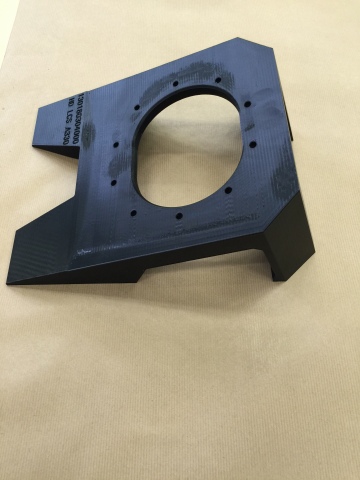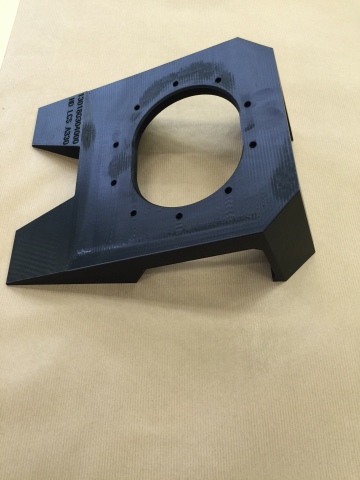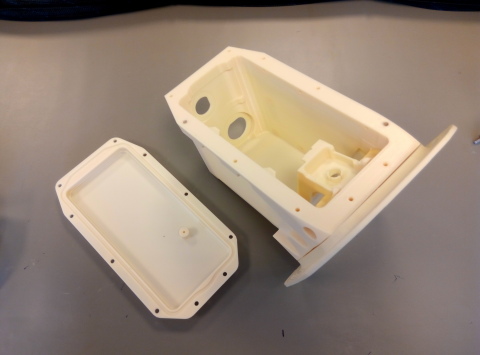MINNEAPOLIS & REHOVOT, Israel--(BUSINESS WIRE)--Stratasys (Nasdaq:SSYS), a global leader in applied additive technology solutions today announced that French aircraft design and manufacturing group, Latécoère, is deploying Stratasys FDM additive manufacturing throughout its design and production process, accelerating the development process and improving business performance.
Faced with lengthy lead-times and costly design iterations, Latécoère – which services aerospace giants including Airbus, Bombardier and Dassault – is using its Stratasys Fortus 450mc Production 3D Printer for both rapid prototyping and production tooling. According to Simon Rieu, Composite and Additive Manufacturing Manager at Latécoère’s R&D and Innovation Center, the adoption of this technology has been transformational for both design and manufacturing.
“Additive manufacturing has integrated seamlessly into our design and production process, and has seen us enjoy improved lead-times, reduced costs and enhanced operational efficiency,” he says. “As the requirements of the aerospace industry become more demanding, we’re also mindful of the need to maintain our competitive edge, and Stratasys additive manufacturing enables us to meet that objective.”
Accelerating Design Validation
Traditionally, the company uses CNC machining for rapid prototyping, but this has presented limitations. “We recently produced a 3D printed prototype to verify the fit and function of a part for the interior lining of an aircraft door,” explains Rieu. “Previously, this would have been made from sheet metal – an often-time-consuming process. With our Fortus 450mc 3D Printer, we produced a fully-functional prototype in two days, reducing our lead times by a staggering 95%. Crucially this has accelerated our design validation process before committing to costly and time-consuming tooling.”
Latécoère recently 3D printed a prototype camera case for the Airbus A380 aircraft for design validation with the camera’s internal parts housed inside. Prior to Stratasys FDM 3D additive manufacturing, the team would have been forced to directly manufacture an aluminum camera case for testing, with any design iterations proving costly. Using ULTEM 9085 material, the 3D printed prototype is also 50% lighter than its metal counterpart, enabling more efficient functional part testing.
Enhancing production tooling
The company is also utilizing its Fortus 450mc 3D Printer for the on-demand manufacture of customized production tools. This has not only seen significant reductions in time and cost, but also enhanced operator efficiency.
“Using metal sheet manufacturing, creating a tool can take up to six weeks. Now we can 3D print a tool in just two days and 50% lighter using ULTEM 9085 material,” says Rieu. “With our 3D printer, we can also optimize the geometry of the tool to perfectly fit the part – making the operator’s job much easier. Not only has this accelerated our production process dramatically, but I also estimate that we’ve reduced our tool production costs by a massive 40%.”
Final flight-ready 3D printed production parts
Looking ahead, Latécoère’s long-term strategy is to 3D print final production parts for next generation airplanes from the likes of Airbus, Boeing, and other leading aircraft manufacturers. Indeed, the company has already begun exploring the potential to utilize its Fortus 450mc to produce final interior aircraft parts with certification in mind. Using Stratasys’ tough, lightweight and FST compliant ULTEM 9085 material, the team has 3D printed various air duct housing components, which has seen significant weight reductions and time savings compared to traditional production methods.
Andy Middleton, President of EMEA, Stratasys, concludes, “Latécoère, like many of our aerospace customers, are benefiting from our proven FDM technology and high-performance materials for this industry. Our application-driven approach enables us to have a close interface with our customers to develop solutions optimized for their design and production processes. Whether it’s accelerating design validation or the on-demand production of lightweight manufacturing tools, or even 3D printed interior aircraft parts, we are committed to ensuring our customers are given the right tools to optimize the use of additive manufacturing.”
About Stratasys
Stratasys (NASDAQ: SSYS) is a global leader in applied additive technology solutions for industries including Aerospace, Automotive, Healthcare, Consumer Products and Education. For nearly 30 years, a deep and ongoing focus on customers’ business requirements has fueled purposeful innovations—1,200 granted and pending additive technology patents to date—that create new value across product lifecycle processes, from design prototypes to manufacturing tools and final production parts. The Stratasys 3D printing ecosystem of solutions and expertise—advanced materials; software with voxel level control; precise, repeatable and reliable FDM and PolyJet 3D printers; application-based expert services; on-demand parts and industry-defining partnerships—works to ensure seamless integration into each customer’s evolving workflow. Fulfilling the real-world potential of additive, Stratasys delivers breakthrough industry-specific applications that accelerate business processes, optimize value chains and drive business performance improvements for thousands of future-ready leaders around the world.
Corporate Headquarters: Minneapolis, Minnesota and Rehovot, Israel.
Online at: www.stratasys.com, http://blog.stratasys.com and LinkedIn.
Stratasys is a registered trademark and Fortus and Stratasys signet are trademarks or registered trademarks of Stratasys Ltd. and or its subsidiaries or affiliates. All other trademarks belong to their respective owners.
Attention Editors, if you publish reader-contact information, please use:
- USA 1-877-489-9449
- Europe/Middle East/Africa +49-7229-7772-0
- Asia Pacific +852 3944-8888





